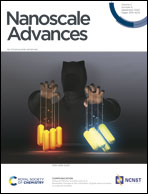Highly swelling pH-responsive microgels for dual mode near infra-red fluorescence reporting and imaging†
Abstract
Near infra-red (NIR) fluorescence is a desirable property for probe particles because such deeply penetrating light enables remote reporting of the local environment in complex surroundings and imaging. Here, two NIR non-radiative energy transfer (NRET) fluorophores (Cy5 and Cy5.5) are coupled to preformed pH-responsive poly(ethylacrylate-methacrylic acid-divinylbenzene) microgel particles (PEA-MAA-5/5.5 MGs) to obtain new NIR fluorescent probes that are cytocompatible and swell strongly. NIR ratiometric photoluminescence (PL) intensity analysis enables reporting of pH-triggered PEA-MAA-5/5.5 MG particle swelling ratios over a very wide range (from 1–90). The dispersions have greatly improved colloidal stability compared to a reference temperature-responsive NIR MG based on poly(N-isopropylacrylamide) (PNP-5/5.5). We also show that the wavelength of maximum PL intensity (λmax) is a second PL parameter that enables remote reporting of swelling for both PEA-MAA-5/5.5 and PNP-5/5.5 MGs. After internalization the PEA-MAA-5/5.5 MGs are successfully imaged in stem cells using NIR light. They are also imaged after subcutaneous injection into model tissue using NIR light. The new NIR PEA-MAA-5/5.5 MGs have excellent potential for reporting their swelling states (and any changes) within physiological settings as well as very high ionic strength environments (e.g., waste water).



 Please wait while we load your content...
Please wait while we load your content...